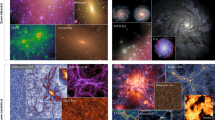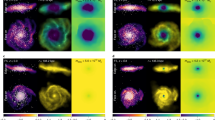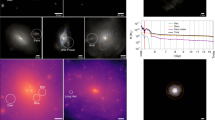Abstract
Galaxy formation simulations are an essential part of the modern toolkit of astrophysicists and cosmologists alike. Astrophysicists use the simulations to study the emergence of galaxy populations from the Big Bang, as well as the formation of stars and supermassive black holes. For cosmologists, galaxy formation simulations are needed to understand how baryonic processes affect measurements of dark matter and dark energy. Owing to the extreme dynamic range of galaxy formation, advances are driven by novel approaches using simulations with different tradeoffs between volume and resolution. Large-volume but low-resolution simulations provide the best statistics, while higher-resolution simulations of smaller cosmic volumes can be evolved with self-consistent physics and reveal important emergent phenomena. I summarize recent progress in galaxy formation simulations, including major developments in the past five years, and highlight some key areas likely to drive further advances over the next decade.
This is a preview of subscription content, access via your institution
Access options
Access Nature and 54 other Nature Portfolio journals
Get Nature+, our best-value online-access subscription
$29.99 / 30 days
cancel any time
Subscribe to this journal
Receive 12 digital issues and online access to articles
$119.00 per year
only $9.92 per issue
Buy this article
- Purchase on Springer Link
- Instant access to full article PDF
Prices may be subject to local taxes which are calculated during checkout

adapted from ref. 73, Oxford Univ. Press.

adapted from ref. 46, Oxford Univ. Press.
Similar content being viewed by others
References
Planck Collaboration, Ade, P. A. R. et al. Planck 2015 results. XIII. Cosmological parameters. Astron. Astrophys. 594, A13 (2016).
Heitmann, K., White, M., Wagner, C., Habib, S. & Higdon, D. The Coyote Universe. I. Precision determination of the nonlinear matter power spectrum. Astrophys. J. 715, 104–121 (2010).
van Daalen, M. P., Schaye, J., Booth, C. M. & Dalla Vecchia, C. The effects of galaxy formation on the matter power spectrum: a challenge for precision cosmology. Mon. Not. R. Astron. Soc. 415, 3649–3665 (2011).
White, S. D. M. & Frenk, C. S. Galaxy formation through hierarchical clustering. Astrophys. J. 379, 52–79 (1991).
Somerville, R. S., Primack, J. R. & Faber, S. M. The nature of high-redshift galaxies. Mon. Not. R. Astron. Soc. 320, 504–528 (2001).
Behroozi, P. S., Wechsler, R. H. & Conroy, C. The average star formation histories of galaxies in dark matter halos from z = 0–8. Astrophys. J. 770, 57 (2013).
Moster, B. P., Naab, T. & White, S. D. M. Galactic star formation and accretion histories from matching galaxies to dark matter haloes. Mon. Not. R. Astron. Soc. 428, 3121–3138 (2013).
Hearin, A. P. & Watson, D. F. The dark side of galaxy colour. Mon. Not. R. Astron. Soc. 435, 1313–1324 (2013).
Navarro, J. F. & White, S. D. M. Simulations of dissipative galaxy formation in hierarchically clustering universes-2. Dynamics of the baryonic component in galactic haloes. Mon. Not. R. Astron. Soc. 267, 401–412 (1994).
Larson, R. B. Effects of supernovae on the early evolution of galaxies. Mon. Not. R. Astron. Soc. 169, 229–246 (1974).
Dekel, A. & Silk, J. The origin of dwarf galaxies, cold dark matter, and biased galaxy formation. Astrophys. J. 303, 39–55 (1986).
Thacker, R. J. & Couchman, H. M. P. Star formation, supernova feedback, and the angular momentum problem in numerical cold dark matter cosmogony: halfway there? Astrophys. J. Lett. 555, L17–L20 (2001).
Stinson, G. et al. Star formation and feedback in smoothed particle hydrodynamic simulations - I. Isolated galaxies. Mon. Not. R. Astron. Soc. 373, 1074–1090 (2006).
Dalla Vecchia, C. & Schaye, J. Simulating galactic outflows with thermal supernova feedback. Mon. Not. R. Astron. Soc. 426, 140–158 (2012).
Springel, V. & Hernquist, L. The history of star formation in a Λ cold dark matter universe. Mon. Not. R. Astron. Soc. 339, 312–334 (2003).
Oppenheimer, B. D. & Davé, R. Cosmological simulations of intergalactic medium enrichment from galactic outflows. Mon. Not. R. Astron. Soc. 373, 1265–1292 (2006).
Oppenheimer, B. D. et al. Feedback and recycled wind accretion: assembling the z = 0 galaxy mass function. Mon. Not. R. Astron. Soc. 406, 2325–2338 (2010).
Guedes, J., Callegari, S., Madau, P. & Mayer, L. Forming realistic late-type spirals in a ΛCDM Universe: The Eris Simulation. Astrophys. J. 742, 76 (2011).
Schaye, J. et al. The physics driving the cosmic star formation history. Mon. Not. R. Astron. Soc. 402, 1536–1560 (2010).
Crain, R. A. et al. The EAGLE simulations of galaxy formation: calibration of subgrid physics and model variations. Mon. Not. R. Astron. Soc. 450, 1937–1961 (2015).
Vogelsberger, M. et al. Introducing the Illustris Project: simulating the coevolution of dark and visible matter in the Universe. Mon. Not. R. Astron. Soc. 444, 1518–1547 (2014).
Schaye, J. et al. The EAGLE project: simulating the evolution and assembly of galaxies and their environments. Mon. Not. R. Astron. Soc. 446, 521–554 (2015).
Benson, A. J. et al. What shapes the luminosity function of galaxies? Astrophys. J. 599, 38–49 (2003).
Croton, D. J. et al. The many lives of active galactic nuclei: cooling flows, black holes and the luminosities and colours of galaxies. Mon. Not. R. Astron. Soc. 365, 11–28 (2006).
Somerville, R. S. & Davé, R. Physical models of galaxy formation in a cosmological framework. Ann. Rev. Astron. Astrophys. 53, 51–113 (2015).
Nelson, D. et al. First results from the IllustrisTNG simulations: the galaxy colour bimodality. Mon. Not. R. Astron. Soc. 475, 624–647 (2018).
Trayford, J. W. et al. Optical colours and spectral indices of z = 0.1 EAGLE galaxies with the 3D dust radiative transfer code skirt. Mon. Not. R. Astron. Soc. 470, 771–799 (2017).
Faucher-Giguère, C.-A. et al. Neutral hydrogen in galaxy haloes at the peak of the cosmic star formation history. Mon. Not. R. Astron. Soc. 449, 987–1003 (2015).
Turner, M. L., Schaye, J., Crain, R. A., Theuns, T. & Wendt, M. Observations of metals in the z ~ 3.5 intergalactic medium and comparison to the EAGLE simulations. Mon. Not. R. Astron. Soc. 462, 2440–2464 (2016).
Suresh, J. et al. On the OVI abundance in the circumgalactic medium of low-redshift galaxies. Mon. Not. R. Astron. Soc. 465, 2966–2982 (2017).
Snyder, G. F. et al. Galaxy morphology and star formation in the Illustris Simulation at z = 0. Mon. Not. R. Astron. Soc. 454, 1886–1908 (2015).
Segers, M. C. et al. Recycled stellar ejecta as fuel for star formation and implications for the origin of the galaxy mass-metallicity relation. Mon. Not. R. Astron. Soc. 456, 1235–1258 (2016).
Springel, V. et al. First results from the IllustrisTNG simulations: matter and galaxy clustering. Mon. Not. R. Astron. Soc. 475, 676–698 (2018).
Padoan, P., Haugbølle, T. & Nordlund, Å. A simple law of star formation. Astrophys. J. Lett. 759, L27 (2012).
Krumholz, M. R., Dekel, A. & McKee, C. F. A Universal, local star formation law in galactic clouds, nearby galaxies, high-redshift disks, and starbursts. Astrophys. J. 745, 69 (2012).
Raskutti, S., Ostriker, E. C. & Skinner, M. A. Numerical simulations of turbulent molecular clouds regulated by radiation feedback forces. I. Star formation rate and efficiency. Astrophys. J. 829, 130 (2016).
Richings, A. J. & Schaye, J. Chemical evolution of giant molecular clouds in simulations of galaxies. Mon. Not. R. Astron. Soc. 460, 2297–2321 (2016).
Davé, R., Thompson, R. & Hopkins, P. F. MUFASA: galaxy formation simulations with meshless hydrodynamics. Mon. Not. R. Astron. Soc. 462, 3265–3284 (2016).
Stinson, G. S. et al. Making galaxies in a cosmological context: the need for early stellar feedback. Mon. Not. R. Astron. Soc. 428, 129–140 (2013).
Agertz, O. & Kravtsov, A. V. On the interplay between star formation and feedback in galaxy formation simulations. Astrophys. J. 804, 18 (2015).
Wetzel, A. R. et al. Reconciling dwarf galaxies with ΛCDM cosmology: simulating a realistic population of satellites around a Milky Way-mass galaxy. Astrophys. J. Lett. 827, L23 (2016).
Fitts, A. et al. FIRE in the field: simulating the threshold of galaxy formation. Mon. Not. R. Astron. Soc. 471, 3547–3562 (2017).
Martizzi, D., Faucher-Giguère, C.-A. & Quataert, E. Supernova feedback in an inhomogeneous interstellar medium. Mon. Not. R. Astron. Soc. 450, 504–522 (2015).
Girichidis, P. et al. The SILCC (SImulating the LifeCycle of molecular Clouds) project - II. Dynamical evolution of the supernova-driven ISM and the launching of outflows. Mon. Not. R. Astron. Soc. 456, 3432–3455 (2016).
Fielding, D., Quataert, E., Martizzi, D. & Faucher-Giguère, C.-A. How supernovae launch galactic winds? Mon. Not. R. Astron. Soc. 470, L39–L43 (2017).
Hopkins, P. F. et al. Galaxies on FIRE (Feedback In Realistic Environments): stellar feedback explains cosmologically inefficient star formation. Mon. Not. R. Astron. Soc. 445, 581–603 (2014).
Kim, C.-G. & Ostriker, E. C. Momentum injection by supernovae in the interstellar medium. Astrophys. J. 802, 99 (2015).
Kimm, T., Cen, R., Devriendt, J., Dubois, Y. & Slyz, A. Towards simulating star formation in turbulent high-z galaxies with mechanical supernova feedback. Mon. Not. R. Astron. Soc. 451, 2900–2921 (2015).
Keller, B. W., Wadsley, J., Benincasa, S. M. & Couchman, H. M. P. A superbubble feedback model for galaxy simulations. Mon. Not. R. Astron. Soc. 442, 3013–3025 (2014).
Agertz, O., Kravtsov, A. V., Leitner, S. N. & Gnedin, N. Y. Toward a complete accounting of energy and momentum from stellar feedback in galaxy formation simulations. Astrophys. J. 770, 25 (2013).
Aumer, M., White, S. D. M., Naab, T. & Scannapieco, C. Towards a more realistic population of bright spiral galaxies in cosmological simulations. Mon. Not. R. Astron. Soc. 434, 3142–3164 (2013).
Salem, M., Bryan, G. L. & Hummels, C. Cosmological simulations of galaxy formation with cosmic rays. Astrophys. J. Lett. 797, L18 (2014).
Núñez, A. et al. Modeling for stellar feedback in galaxy formation simulations. Astrophys. J. 836, 204 (2017).
Anglés-Alcázar, D. et al. Black holes on FIRE: stellar feedback limits early feeding of galactic nuclei. Mon. Not. R. Astron. Soc. 472, L109–L114 (2017).
Weinberger, R., Ehlert, K., Pfrommer, C., Pakmor, R. & Springel, V. Simulating the interaction of jets with the intracluster medium. Mon. Not. R. Astron. Soc. 470, 4530–4546 (2017).
Leitherer, C. et al. Starburst99: Synthesis models for galaxies with active star formation. Astrophys. J. Supplement 123, 3–40 (1999).
Muratov, A. L. et al. Gusty, gaseous flows of FIRE: galactic winds in cosmological simulations with explicit stellar feedback. Mon. Not. R. Astron. Soc. 454, 2691–2713 (2015).
Kennicutt, R. C. Jr The global Schmidt law in star-forming galaxies. Astrophys. J. 498, 541–552 (1998).
Davé, R., Finlator, K. & Oppenheimer, B. D. An analytic model for the evolution of the stellar, gas and metal content of galaxies. Mon. Not. R. Astron. Soc. 421, 98–107 (2012).
Governato, F. et al. Cuspy no more: how outflows affect the central dark matter and baryon distribution in Λ cold dark matter galaxies. Mon. Not. R. Astron. Soc. 422, 1231–1240 (2012).
Teyssier, R., Pontzen, A., Dubois, Y. & Read, J. I. Cusp-core transformations in dwarf galaxies: observational predictions. Mon. Not. R. Astron. Soc. 429, 3068–3078 (2013).
Domínguez, A. et al. Consequences of bursty star formation on galaxy observables at high redshifts. Mon. Not. R. Astron. Soc. 451, 839–848 (2015).
Governato, F. et al. Bulgeless dwarf galaxies and dark matter cores from supernova-driven outflows. Nature 463, 203–206 (2010).
Di Cintio, A. et al. The dependence of dark matter profiles on the stellar-to-halo mass ratio: a prediction for cusps versus cores. Mon. Not. R. Astron. Soc. 437, 415–423 (2014).
Chan, T. K. et al. The impact of baryonic physics on the structure of dark matter haloes: the view from the FIRE cosmological simulations. Mon. Not. R. Astron. Soc. 454, 2981–3001 (2015).
Vogelsberger, M., Zavala, J., Simpson, C. & Jenkins, A. Dwarf galaxies in CDM and SIDM with baryons: observational probes of the nature of dark matter. Mon. Not. R. Astron. Soc. 444, 3684–3698 (2014).
Sawala, T. et al. The APOSTLE simulations: solutions to the Local Group’s cosmic puzzles. Mon. Not. R. Astron. Soc 457, 1931–1943 (2016).
Gentile, G., Salucci, P., Klein, U., Vergani, D. & Kalberla, P. The cored distribution of dark matter in spiral galaxies. Mon. Not. R. Astron. Soc. 351, 903–922 (2004).
de Blok, W. J. G. et al. High-resolution rotation curves and galaxy mass models from THINGS. Astron. J. 136, 2648–2719 (2008).
Oman, K. A. et al. Apparent cores and non-circular motions in the HI discs of simulated galaxies. Preprint at https://arxiv.org/abs/1706.07478 (2017).
Magorrian, J. et al. The demography of massive dark objects in galaxy centers. Astron. J. 115, 2285–2305 (1998).
Habouzit, M., Volonteri, M. & Dubois, Y. Blossoms from black hole seeds: properties and early growth regulated by supernova feedback. Mon. Not. R. Astron. Soc. 468, 3935–3948 (2017).
Faucher-Giguère, C.-A. A model for the origin of bursty star formation in galaxies. Mon. Not. R. Astron. Soc. 473, 3717–3731 (2018).
Author information
Authors and Affiliations
Corresponding author
Ethics declarations
Competing interests
The author declares no competing interests.
Additional information
Publisher's note: Springer Nature remains neutral with regard to jurisdictional claims in published maps and institutional affiliations.
Rights and permissions
About this article
Cite this article
Faucher-Giguère, CA. Recent progress in simulating galaxy formation from the largest to the smallest scales. Nat Astron 2, 368–373 (2018). https://doi.org/10.1038/s41550-018-0427-y
Received:
Accepted:
Published:
Issue Date:
DOI: https://doi.org/10.1038/s41550-018-0427-y
This article is cited by
-
Galaxies lacking dark matter produced by close encounters in a cosmological simulation
Nature Astronomy (2022)
-
The IllustrisTNG simulations: public data release
Computational Astrophysics and Cosmology (2019)



